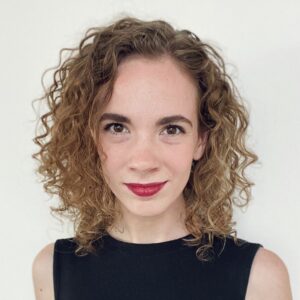
Interdisciplinary physicist Mariel Pettee uses techniques grounded in machine learning to study a range of topics that span high energy physics and astrophysics, with an ultimate goal of developing a better understanding of the fundamental physical building blocks of our Universe.
Originally from Dallas, TX, Pettee was a physics and mathematics undergraduate at Harvard University, a master’s student in physics at the University of Cambridge, and a PhD student in physics at Yale University. While pursuing a postdoc at Lawrence Berkeley National Lab, she also joined the Flatiron Institute in New York City as a guest researcher. She then joined the UW–Madison physics faculty as part of the RISE-AI initiative in August 2025.
Please give an overview of your research.
My background is in high energy physics, and that training has fundamentally shaped the way I approach my work. But over the past several years, I have become more of what you might call a “data physicist” — someone with physics expertise who works at the intersection of physics and data science. In particular, I’m interested in how machine learning can help us do interdisciplinary physics research and make discoveries using massive experimental datasets that would otherwise be out of our reach.
On a broad scale, my research touches on high energy particle physics and astrophysics through the lens of machine learning. Some of my work applies recent machine learning techniques to domain-specific problems such as anomaly detection, object reconstruction, and unfolding. Another part of my work explores core questions in machine learning in areas such as self-supervised learning and likelihood-free inference in a physics-driven way. I’m also interested in developing large-scale foundation models for broader scientific use.
What are one or two main projects you’ll have your group focus on first?
The field of scientific foundation models has been rapidly taking shape over the last couple of years, but there are still a lot of open questions to explore. By researching what might make training foundation models on fundamental physics data distinct from training on more common industry-standard data, I think there is significant potential to understand our data more deeply.
I’m interested in simultaneously incorporating information from multiple heterogeneous layers of a detector, e.g. time series, images, and point clouds, as well as across detectors. Early projects in this direction will develop a variety of self-supervised learning strategies on multimodal HEP and astrophysics data to understand how models can simultaneously incorporate many different types of measurements of the same physics objects.
I’m also interested in studying stellar streams, which are remnants of ancient galaxies or globular clusters being absorbed into the Milky Way and serve as interesting tracers of local dark matter. The first step is to simply detect more of them using unsupervised or weakly supervised anomaly detection: trying to learn with no labels or with imperfect or missing labels. We can use machine learning models to automatically detect resonant anomalies in data, and stellar streams emerge as resonant anomalies in velocity space due to their constituents’ shared origin.
I’m optimistic that we will also eventually be able to use aggregate stream information to better map local dark matter substructure. Beyond their immediate physics use cases, streams can also serve as a nice testbed for understanding the limits of domain transfer for foundation models due to their resonant properties: perhaps particle physics data, with its 3D point cloud structure and “bump”-like anomalies, has more shared information with streams from the perspective of a foundation model than one might initially expect.
What attracted you to Madison and the university?
I felt a strong fit with Madison and the university from my first visit. I think that’s a combination of the general spirit of the department, how warm and open it felt, and how much I admired the researchers that I met when I was here. Also, the nature of the position that I was offered gave me the kind of flexibility that I dreamed of — to work and move between these spaces of high energy physics, astrophysics, and machine learning with a lot of freedom.
What is your favorite element and/or elementary particle?
Well, I have to pick a particle! I got into physics because of the Higgs boson. I started my physics career as an undergraduate at CERN on July 1st, 2012, and then the discovery of the Higgs boson was announced three days later. So I think I have the Higgs to thank for really getting me energized about this field. Waking up so early that morning, witnessing those presentations, seeing hundreds of people buzzing with excitement, scribbling on chalkboards, popping champagne corks — it made me feel like I was in the center of the universe.
What hobbies and interests do you have?
I love the performing arts of all kinds—contemporary dance, theater, music. I’m a dancer, choreographer, and occasional actor and director. I’m also an amateur birdwatcher.